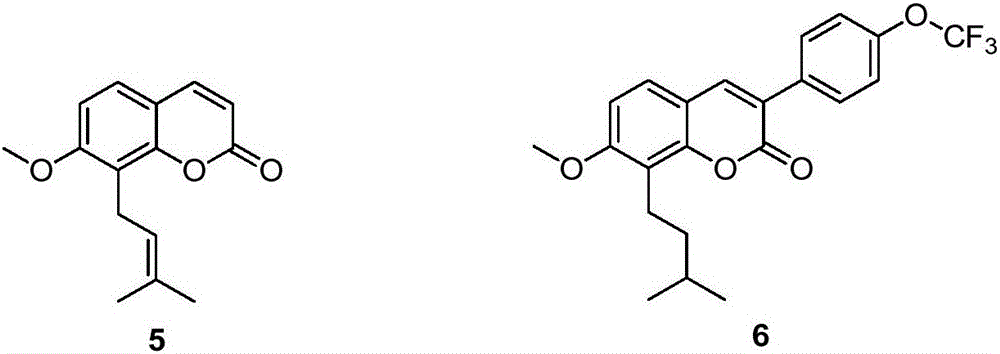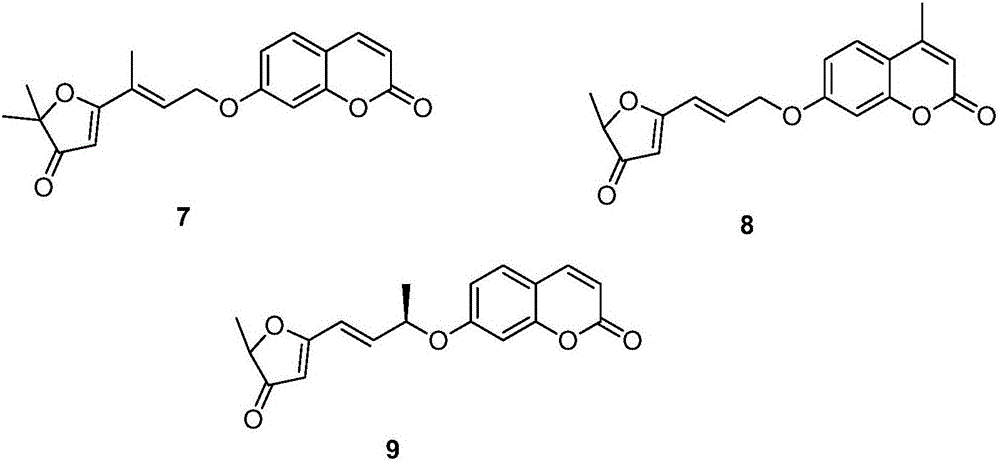3-(2-aryl-1H-indol-3-yl)-4-hydroxycoumarin derivative and synthetic method thereof
A technology of hydroxycoumarin and its synthesis method, which is applied in the field of new compound 3--4-hydroxycoumarin derivatives and its synthesis, and can solve the problems of low bioavailability, limited clinical application, and limited natural existence , to achieve the effect of simple conditions, high atom economy and short reaction time
- Summary
- Abstract
- Description
- Claims
- Application Information
AI Technical Summary
Problems solved by technology
Method used
Image
Examples
Embodiment 1
[0043] Add 4-hydroxycoumarin (1mmol), phenylglyoxal (1mmol), p-methylaniline (1mmol) into the microwave reaction tube, and then add 4mL EtOH / H 2 O (volume ratio is 1:1), shake slightly to mix the substrate evenly, add dropwise (0.2mmol) trifluoroacetic acid, react in a microwave reactor at 90°C for 40min, monitor the reaction progress with TLC, after the reaction is completed, , cooling, the reaction mixture was obtained by column chromatography as 3-(5-methyl-2-phenyl-1H-indol-3-yl)-4-hydroxycoumarin (compound IVa), and the yield was 49%; melting point is 244-245°C; 1 H NMR (400MHz, DMSO-d 6 )δ (ppm): 11.49 (s, 1H, OH), 11.00 (s, 1H, NH), 7.91 (d, J = 7.6Hz, 1H, ArH), 7.67 (t, J = 8.8Hz, 1H, ArH ), 7.60(d, J=8.0Hz, 2H, ArH), 7.44(d, J=8.0Hz, 1H, ArH), 7.40-7.34(m, 4H, ArH), 7.26(t, J=7.2Hz, 1H, ArH), 6.99(t, J=6.0Hz, 2H, ArH), 2.34(s, 3H, CH 3 ).
Embodiment 2
[0045] According to the method of Example 1, p-methylaniline was replaced by p-tert-butylaniline, trifluoroacetic acid was used as a catalyst, microwave reaction was carried out at 90°C for 40 minutes, and the target product was obtained by column chromatography, which was 3-(5-tert-butyl -2-phenyl-1H-indol-3-yl)-4-hydroxycoumarin (compound IVb), yield 75%; melting point 174~175°C; 1 H NMR (400MHz, DMSO-d 6 )δ (ppm): 11.51 (s, 1H, OH), 10.96 (s, 1H, NH), 7.93 (d, J = 8.0Hz, 1H, ArH), 7.67 (t, J = 8.8Hz, 1H, ArH ), 7.67(t, J=7.2Hz, 1H, ArH), 7.61(d, J=7.6Hz, 2H, ArH), 7.44(t, J=8.4Hz, 2H, ArH), 7.38(t, J= 8.0Hz,3H,ArH),7.29-7.25(m,2H,ArH),7.19(s,1H,ArH),1.30(s,9H,(CH 3 ) 3 C).
Embodiment 3
[0047] According to the method of Example 1, p-methylaniline was replaced by m-chloroaniline, and trifluoroacetic acid was used as a catalyst, and reacted at 90° C. for 40 minutes under microwave radiation, and the target product was obtained by column chromatography, which was 3-(6-chloro- 2-Phenyl-1H-indol-3-yl)-4-hydroxycoumarin (compound IVc), yield 31%; melting point 253-254°C; 1 H NMR (400MHz, DMSO-d 6 )δ (ppm): 11.82 (s, 1H, OH), 11.12 (s, 1H, NH), 7.93 (d, J = 8.0Hz, 1H, ArH), 7.69-7.62 (m, 3H, ArH), 7.50 (s, 1H, ArH), 7.46-7.36 (m, 4H, ArH), 7.32-7.26 (m, 2H, ArH), 7.03 (d, J=8.0Hz, 1H, ArH).
PUM
 Login to View More
Login to View More Abstract
Description
Claims
Application Information
 Login to View More
Login to View More - R&D
- Intellectual Property
- Life Sciences
- Materials
- Tech Scout
- Unparalleled Data Quality
- Higher Quality Content
- 60% Fewer Hallucinations
Browse by: Latest US Patents, China's latest patents, Technical Efficacy Thesaurus, Application Domain, Technology Topic, Popular Technical Reports.
© 2025 PatSnap. All rights reserved.Legal|Privacy policy|Modern Slavery Act Transparency Statement|Sitemap|About US| Contact US: help@patsnap.com



